Nimue Brown's Blog, page 316
July 17, 2016
Re-thinking Nemeton Space
Back when I first started studying Druidry, many moons ago, I was introduced to the idea of Nemeton space – a magical, sacred energy space surrounding living things, and if your animism stretches that far, inanimate things, too. All kinds of physical presences either have or impact on energy in discernible ways, nothing non-sciency there! Our bodies are full of measurable electrical impulses, many creatures can sense the earth’s electromagnetic fields to use for navigation and so forth. Things have energy, energy can be experienced.
Early on it was a concept I worked with quite a lot, and I drifted away from it. I feel no resonance with Nemetona as a goddess, and while I can busy myself figuring out where the perceptible edges of spaces are, it didn’t seem to be going anywhere for me. This week, in a contemplative Druid session, I had a bit of a revelation, and while I haven’t done much with it as yet, I’m sufficiently enthused to want to write anyway.
Approach a tree, looking for the edge of its nemeton and ask to be allowed to enter. Maybe you’ll get a response and some kind of connection between you and the tree. This is pretty much what I was taught to do. But what is a tree? Roots engaging with soil, and fungi networks that can traverse whole woodlands. Smaller plants around the base. Insects living in the bark and on the leaves, birds coming and going to shelter, feed, nest. Larger mammals visiting the base of the tree, squirrels and perhaps bats in the branches, more birds above. Rain fall, and water moving through soil. A tree is not a distinct and stand alone thing. It is part of a greater whole, as is everything. The tree is within the nemeton of the wood, or the hedge, or the field…
Some nemeton spaces are more stationary than others, although the wind will move plants in and out of each other’s spaces, rocks move, water moves all kinds of things from time to time. We mobile creatures are in constant shifting relationship with other energies and spaces. When I ask the tree if I can enter its space, whose space am I already standing in? And who am I ignoring when I speak to the tree?
I’ve noticed that when I’m open hearted to the world around me, I encounter a lot of it. I’ve blogged about that recently. How I’m doing it, I’ve been uncertain. If we are all in interconnected patterns of energy and overlap, then the knowledge of what is around us might be felt in the body. Wild things are all busy paying attention to each other, by whatever means. Creatures can seem to have an uncanny knowledge of what’s around them – many see, hear and smell far more effectively than we do, but I would bet they also feel more effectively than we do. I have found how to feel first, and apply my senses to checking out what I felt. I’ve got better at using those senses because I’m prompting myself to use them with intent not just see what wafts in.
I’ve never been really excited about the idea of nemeton space before. Circles within circles, though. Threads, loops and chains of connection between all things, all places… that’s an exciting thought. I don’t have to do anything, I am part of this already, but in knowing, in embracing it, I expect there will be change.


July 16, 2016
Poem – How to be a purist
How to be a purist
Send them back to America where they belong,
Wretched potatoes. Evict the rice.
Bloody foreigners, coming over here
Becoming our staples. And the pasta.
Italian nonsense, noodle inspired.
And let me tell you, noodles are not
From round here either.
Send the sweeds back to Sweden
And the brussel sprouts back to Brussels.
Send back the Danish pastry, the Viennese whirl
The champaign, parmesan, parma ham.
Remove the korma, curry and kebab,
Hound out the homous and hallumi
Say no to tapas and tagliatelli,
Forsake feta, forget focaccia.
Let it be English food for England.
Only the turnip. Meat pies.
Fish without chips.
Black Pudding.
Spotted dick.
Semolina.
Patriotism is a dish generally served bland.


July 15, 2016
Things I have been reading
When I review in batches, I often find there are themes. I can’t see any links this time, it’s quite a disparate set, but perhaps that ups the odds of there being something for everyone…
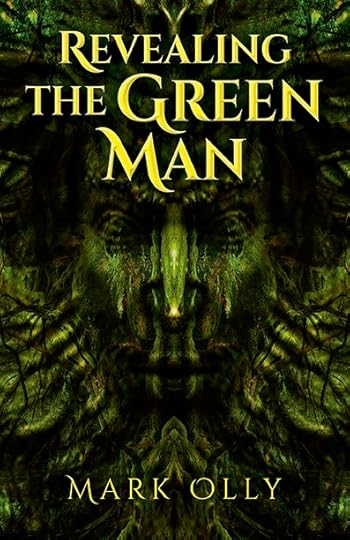 Revealing the Green Man – Mark Olly. This small and startling book comes out in August, and is unlike any Green Man stuff I’ve read previously. I’m not an expert on history or Green Men, though. This book intrigued me, it went into the possibilities of the past, and the implications for the future than I had anticipated. Author Mark Olly lectures in archaeology, it’s worth noting, so can be assumed to know his stuff. I’m not going to say too much about the content, to avoid spoilers, but I will say I found it a wild ride of a read, and far darker than I’d expected. If you wanted to be excited and surprised about this familiar icon of modern Paganism, I think there’s every chance this book will deliver.
Revealing the Green Man – Mark Olly. This small and startling book comes out in August, and is unlike any Green Man stuff I’ve read previously. I’m not an expert on history or Green Men, though. This book intrigued me, it went into the possibilities of the past, and the implications for the future than I had anticipated. Author Mark Olly lectures in archaeology, it’s worth noting, so can be assumed to know his stuff. I’m not going to say too much about the content, to avoid spoilers, but I will say I found it a wild ride of a read, and far darker than I’d expected. If you wanted to be excited and surprised about this familiar icon of modern Paganism, I think there’s every chance this book will deliver.
More about the book here – http://www.moon-books.net/books/revealing-green-man
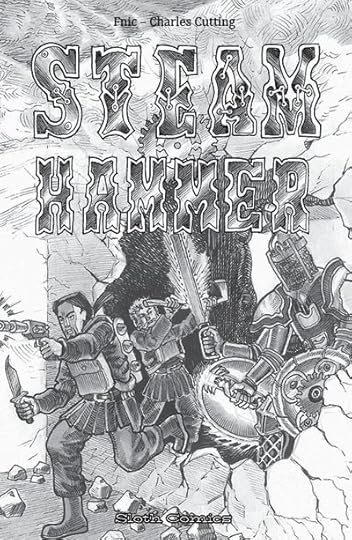 Steam Hammer – story by Fnic, art by Charles Cutting. This is a Steampunk graphic novel set in an alternate reality where the USA is the conquering colonial power, England is in their power and Scotland is fighting back. It’s a bit like an Asterix setup, although far darker and with an alchemist instead of a Druid. This is a story that revolves around action and violence – to a greater degree than I’d normally go for, but if you like that kind of story, it’s well told, great pace, not gratuitous (readers over 12 I think) compelling setting, mechanical horses… I didn’t read it at the speed the story suggests because I spent a lot of time studying the line drawing of Charles Cutting, cooing over his landscape representations and how he does clouds. I’m entirely a fan. It’s part 1 one of a series, ends in a cliffhanger, and I do want to read the next installment.
Steam Hammer – story by Fnic, art by Charles Cutting. This is a Steampunk graphic novel set in an alternate reality where the USA is the conquering colonial power, England is in their power and Scotland is fighting back. It’s a bit like an Asterix setup, although far darker and with an alchemist instead of a Druid. This is a story that revolves around action and violence – to a greater degree than I’d normally go for, but if you like that kind of story, it’s well told, great pace, not gratuitous (readers over 12 I think) compelling setting, mechanical horses… I didn’t read it at the speed the story suggests because I spent a lot of time studying the line drawing of Charles Cutting, cooing over his landscape representations and how he does clouds. I’m entirely a fan. It’s part 1 one of a series, ends in a cliffhanger, and I do want to read the next installment.
More about the book here – http://www.slothcomics.co.uk/steam_hammer.html
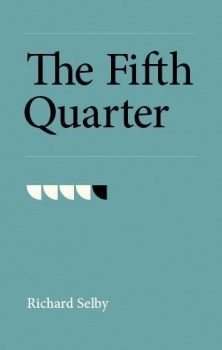 The Fifth Quarter, Richard Selby. Poetry, prose, illustration and photography. This small book represents a love affair with Romney Marsh and is very much written for people besotted with that landscape. Having never been there, I may not be best placed to judge, but I found the writing evocative and it conjured an idea of this landscape for me. There’s a sense of timelessness, and of liminality – between land and sky, sea and shore. Watery landscapes always have that slightly otherworldly quality to them. It’s a charming book, and if Romney Marsh is part of your world, you ought to check this out.
The Fifth Quarter, Richard Selby. Poetry, prose, illustration and photography. This small book represents a love affair with Romney Marsh and is very much written for people besotted with that landscape. Having never been there, I may not be best placed to judge, but I found the writing evocative and it conjured an idea of this landscape for me. There’s a sense of timelessness, and of liminality – between land and sky, sea and shore. Watery landscapes always have that slightly otherworldly quality to them. It’s a charming book, and if Romney Marsh is part of your world, you ought to check this out.
More about the book here – http://www.awenpublications.co.uk/the_fifth_quarter.html


July 14, 2016
A very Druid apocalypse
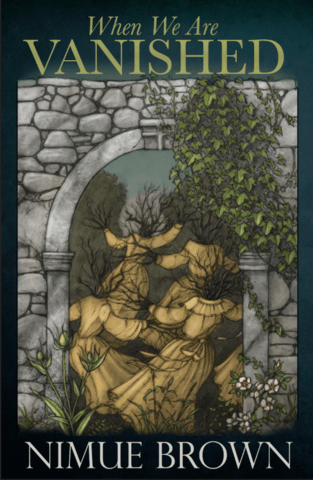 One of the great things about being an author is the being able to kill people and never face any legal consequences. I expect I’m not the only person who looks around at the rest of humanity every now and then and thinks “dear gods, we are a cancerous growth and something must be done about us!”
One of the great things about being an author is the being able to kill people and never face any legal consequences. I expect I’m not the only person who looks around at the rest of humanity every now and then and thinks “dear gods, we are a cancerous growth and something must be done about us!”
As an author, I can have a nice big apocalypse from the safety of my own writing space. I have lavished hours of thought and attention on imagining how I want civilization to end its current incarnation. My most recent novel, When We Are Vanished, is to no small degree, me having my cathartic apocalypse. I’m not an especially bloodthirsty person, and I don’t enjoy reading or writing long gore scenes, so I wanted it clean. The title is something of a giveaway here, because in my perfect apocalypse, people just vanish, melting away like morning mist as the sun comes up. Streets empty of inhabitants, and in their absence, new forests grow up. Apathy, in case you were wondering, is the main reason for this disintegration.
One of the standards of dystopian fiction is the scenario of dwindling resources and the last humans fighting desperate battles over the stuff. I never was much of a fan of owning stuff, so in this setting I’ve got an excess of resources and very few people trying to use them. In this future, you can have as big a house as you want (there are so many empty ones) it’s just a case of how much work you want to do keeping it warm and keeping the trees out. If you can work out how to fuel a car, you can have a car. There is a steam car, the last remaining survivor from my original plan to do this as a more overtly Steampunk setup.
My apocalypse is green. It requires people to knit jumpers and keep goats, although I promise you there’s nothing cute about where that side of things goes. The goat is a total git. I may also have had a ‘wicker man’ moment – not an actual wicker man, you understand, just something of the vibe.
Where I live there are a fair few cottages dotted about the landscape that have become ruins. Old mill sites, more recently abandoned industrial buildings too. Some take a fair bit of spotting. Nature is reclaiming them, and in the normal scheme of things it does not take the plants long to start overrunning our abandoned mess and re-greening. Lost mediaeval villages are little more than bumps in fields. Signs of us disappear at a pleasing speed, when we are vanished.
More about the book here – http://snowbooks.com/products/62388?variant=5508640705


July 13, 2016
Personal Demons (Hopeless, Maine. Vol. 1)
This is a review for the graphic novel series, Hopeless Maine, that I do with Tom…. and it made me very happy…
I went to the library and looked at the graphic novel section. A section I have never paid much attention to previously. I would even say, I avoided it. Comics were for teenage boys and a select group of oddball girls. I could not clarify what I meant by oddball, I mostly just meant not me. After reading the majority of The View from the Cheap Seats by Gaiman, I could no longer hold on to this mental model. I was hungry for a good graphic novel. New to this genre, section, entire form of media, I didn’t know what good meant. I just knew there was a very clear distinction. Armed with this very unclear distinction I went to the library and sat in front of the two shelves of graphic novels. I ignored the full shelf of Superman and Spiderman collections. I looked for the unique and artistic…
View original post 205 more words


July 12, 2016
Presence and Druidry
What does it mean to be present in the moment as a Druid? For me, it has come to mean being in an active state of relationship and engagement with whatever is around me. That doesn’t have to mean being silent – although silence is fine. It doesn’t require me to be ‘alone’, although being the only human is workable, and some humans demand all that active engagement and make it trickier to engage with the non-human. It certainly doesn’t call for bodily stillness, inner stillness or inner silence.
I measure my presence and connection by my ability to notice and respond to other presences. This may mean noticing details of light and the shape of the land. It may mean seeing birds, wild animals, noticing unusual flowers or seeing how the season is progressing. The more open I am to the wild world around me, the more of it I see. I can hold that openness when reading a book, looking up somehow, magically, as the buzzard spirals above me. I can sit at my computer and be open enough to look up when the nuthatches, woodpeckers and other small birds are active in the tree opposite. I’ve raised my head from work to see a heron fly right past my window. I can have conversations with humans while walking and still notice the deer, and stop for them.
I don’t have to greet the world with an empty head. There can be ideas bubbling away. I may have a song as an inner soundtrack, I may be just letting random thoughts collide, but I certainly don’t need inner silence to notice the dragonflies or to spot a tiger moth. I don’t see the flow of inspiration as any kind of distraction from spiritual work – why would I? Awen is sacred. Experiencing inspiration as thought, energy and emotion is part of what it means to me to be in a state of presence and connection. I am not wholly separate from the rest of the world. My thoughts and feelings are part of my process of experiencing and participating in existence.
Quality may be an important issue. The quality of a conversation, or of silence can vary considerably. The quality of the thoughts in my head. Is my inner soundtrack a beautiful and much loved piece of music or an awkward jangle of half remembered commercial pop? What is the quality of attention I am paying to my surroundings? Do I care about what I’m doing? Care creates depth, richness, and opens the way to a better quality of experience. A person can stare hard at the world and still see nothing, can be silent and still not really hear what’s around them, can see and hear, and still not be moved.
And what is Druidry if not a thinking and feeling participation in existence?


July 11, 2016
In search of the comfort zone
I’ve learned a lot this weekend. I have learned that I am not an infinite resource. This may sound blindingly obvious. Intellectually I know I’m not an infinite resource, but nonetheless I’ve spent most of my life acting like I can push and run and whatnot indefinitely. I really, really can’t.
I’ve spent a lot of the last few days lying down. Which of course isn’t productive! It’s clearly time for a radical rethink. At the top of the list is ‘more rest’. We have some new household rules. No one starts work before eight in the morning, and no one works after 8 at night (unless they’re excited about something and need to follow the inspiration). There will be other reshuffles to the day.
I need to tackle the underlying thinking. I need to stop treating effort like virtue, especially when the effort is impacting on my health. I recognise that I am someone whose identity is deeply tied up in ‘doing’ and I am not going to take myself apart to change that – it would not, I feel, be good for me. However, I can re-think ‘doing’. Taking care of my body counts as ‘doing’. Feeding my imagination can go on the ‘doing’ list and so can investing time in my marriage. Meditation is ‘doing’.
I realise that my ‘doing’ has been too much about appeasing an observer. This is not irrational, but there’s no one watching me now who will criticise me. I don’t have to keep appeasing the people who expected me to look busy. Much of the stuff I really need to be ‘doing’ doesn’t look busy from the outside, but it’s no less valuable. No one else has to see it.
The most productive things happen at the margins. The edge of the comfort zone is the best place for innovation. I need to backtrack and find it. I realise I’ve spent a lot of years mostly outside my comfort zone, and that’s no more productive a place than always playing it safe. I end up too afraid and too tired to be creative, and that’s not clever. So in the short term, I will be pulling back (perhaps not visibly) to find my comfort zone, and to get comfortable in it, so that I can go out to the edges from there in a hopefully more meaningful and sustainable sort of way.


July 10, 2016
Perceptions in reviewing
We each come to book reviews as individuals, with different needs and ideas about what a book should do. From an authoring perspective, this is an unwinnable game, because there will always be people who, for perfectly legitimate reasons, wanted your book to have been something else. From the reviewing perspective, it creates all kinds of challenges too. The best reviewers have the self awareness to flag up their own biases such that anyone reading the review can factor that in and make their own judgments.
As a reviewer, I found Fiona Tinker’s Pathworking Through Poetry to be a really interesting book, not least for the way in which it opens up poetry as a tool for pathworking. I wouldn’t work with the poems the authors suggests, but the method the book explores is something I’ve found tremendously helpful. One of my biases is that I like analysis – something this book features heavily. I like to understand things intellectually and I find this deepens my scope to engage emotionally. However, not all readers respond in this way.
Below is a review from Frank Malone – OBOD student and professional psychoanalyst.
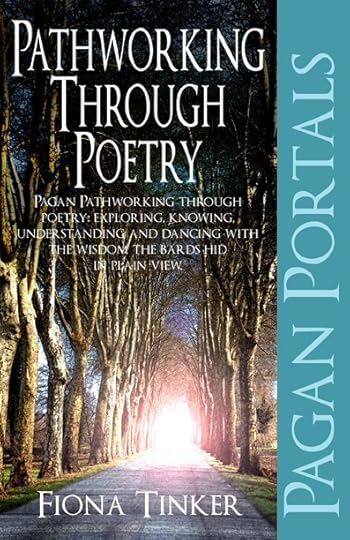 An Ambivalent Appreciation
An Ambivalent Appreciation
I had a significant mix of reactions to Fiona Tinker’s Pathworking Through Poetry: Visions from the Hearts of the Poets. Initially I was attracted by the title. Working as a psychoanalyst, often the best interpretations to patients are like poetry – called overdetermined interpretations. In psychoanalysis, an interpretation is any intervention that is designed to facilitate something unconscious becoming conscious. The overdetermined interpretation (developed in the 1960s by Marie Coleman Nelson, one of my supervisors during training) is a verbal intervention that is ambiguous enough to carry multiple levels of meanings for a patient. Thus there is “projective room” for the patient to interpret to herself whatever is psychologically needed in the moment.
Abundant projective room is one of the characteristics of great art. There must be enough ambiguity for multiple generations and cultures to see their issues addressed in the work. However objective the aesthetic quality of the work may be, it will never be great art to you if it cannot answer one question:
“What does this have to do with me?”
Hence my essential critique of the book. The author gives so much historical and biographical detail about the poems examined that it interfered with my being able to make psychological use of the poetry.
An analogy comes to mind with filmic art. My emotional responses to a work have been diminished by watching behind -the-scenes documentaries. Scenes can feel less magical once the camera tricks are known. (Even though my appreciation of the skill and craft of producing the scene may have increased.)
I found that generally for me, it was not psychologically helpful to know that, for example, in a specific image the poet was actually struggling with a certain set of personal issues. It interfered with using that image for my own healing and self evolution.
Conversely to my above statement however, the author does give specific examples of how historical and biographical particulars can facilitate pathworking. For instance, in discussing the image of the holy Rood in O’Sullivan’s Credo she says helpfully that, “contemplation of the symbolism of the priest hiding behind this dead screen can be a rewarding exercise for those meditating on their position with regards to the religion of their youth” (p.68).
I am however thankful for this book. As a member of the Order of Bards, Ovates, and Druids, I am naturally interested in Celtic history, legends and spirituality. W.B. Yeats was brought to life, and I knew nothing of Fiona MacLeod and Seumus O’Sullivan. As a healer I am drawn to Bridget, and I appreciate how the author facilitated Bridget’s voice. As a mental health professional I also appreciated her comments about psychic vampires, and the importance of psychological and spiritual protection before pathworking. She also emphasises the need to utilise one’s own spiritual tradition in operationalising protection.
I will keep this book as a reference to the poets examined, but not as a tool in my spiritual practise.
* * * * *
Readers who, like me, thrive on understanding the mechanics, and who don’t find that gets in the way of their spirituality, will likely love this book. You can find out more here – http://www.moon-books.net/books/pagan-portals-pathworking-through-poetry Readers who need the room for unrestricted emotional responses probably won’t, although as Frank points out, it’s still very much worth considering this book for what it can teach you about poets working in the Celtic traditions.


July 8, 2016
No Mind, No Matter
In recent weeks I’ve got incredibly good at sitting perfectly in the moment with no thoughts filling up my head with noise. Time ceases to have any meaning. I will share with you the ‘secret’ of this apparent spiritual success. I’m exhausted. When I stop doing the things that need doing, I often can’t pull any coherent lines of thought together. I sit there. Empty. Present. Nothing.
I can’t say I recommend it. Granted, it is a total loss of self and if you’re looking for ego destruction as a spiritual goal, this, I guess, delivers. I can’t honestly say this bears any resemblance to what a really spiritual person exploring mindfulness would get, I’m not that person, I haven’t a clue how that works.
What I can say is that my inner nothingness does not refresh me. It does not fill me with joy and wonder at the world, because to feel those things I would have to be engaging in some way. I am not inspired by the experience because nothing is happening.
About the only good thing I can say for it, is that this process clearly does reduces the pressures on my body for a while. I can’t think, so I can’t panic, or despair either. I can’t hurt my body with problematic emotions. If all I can do is sit there and be in the world, there is some physical restfulness to it, and it would be fair to say that I am very, very tired.
I can’t say I’m enjoying the experience, but I recognise its happening because it is necessary. Because my body really can’t manage anything else sometimes. During the periods where I can gather enough brain power to ponder, I wonder about the relationship between meditation and life experience. Routinely working yourself to a state of exhaustion is often the way of it for those in poverty, and in marginal situations. Here in the west, meditation is something you do if you have time and leisure, as an antidote to all our de-spiritualising first world problems. The empty mind, it turns out, is so much easier to achieve when you’re feeling more physically broken. Perhaps the self martyring Christian mystics were on to something after all. If you like that sort of thing.


July 7, 2016
Blackbird magic
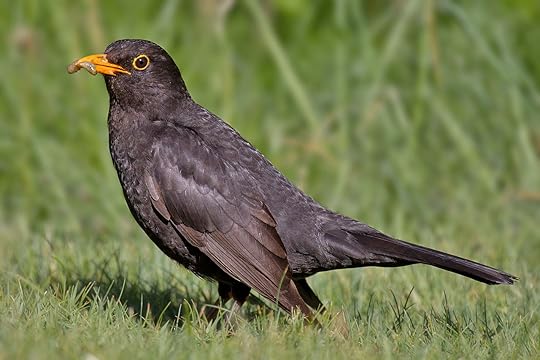
Photo by Andreas Trepte, http://www.photo-natur.de
Blackbirds sing the sun down, as well as singing it up. To my mind, this makes them threshold guardians for the passage between night and day. In quiet surroundings with a fair density of blackbirds, it’s possible to hear them exchanging fragments of melody. They have huge repertoires.
Being modestly sized garden birds, and birds of the wood and hedge, they can turn up pretty much anywhere that worms might be available.
I am entirely convinced that blackbirds also sing about the weather. Between dusk and dawn, they call individually – alarm cries when there are predators about, the odd moment of song, unless a storm is coming. They can get it wrong but on the whole their weather sense is far ahead of mine. I’ve found this reliable enough that hearing a blackbird rainsong will cause me to bring in the laundry even if I’d thought the sky was ok. They’re usually right.
When the rain, or hail, or snow has stopped, they’ll sing again for a little while.
The photo shows a male blackbird – females are brown and do not do as much singing.






